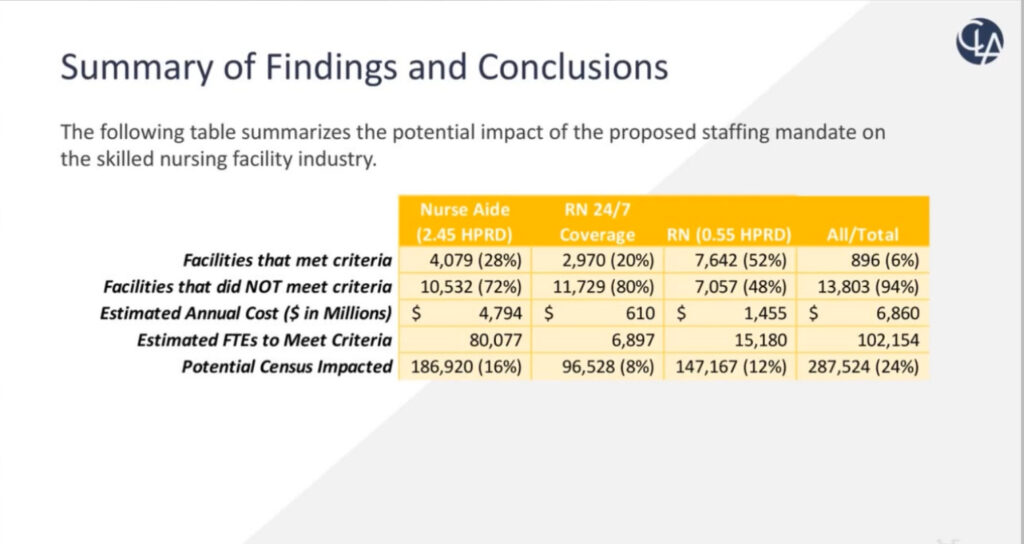
Nursing homes would need to spend more than $6.8 billion annually to meet a proposed federal staffing mandate, which also would require them to hire more than 102,000 new workers if enacted as originally introduced, according to an analysis updated Tuesday by accounting and consulting firm CliftonLarsonAllen.
That projected cost is nearly 60% higher than the $4 billion annual cost estimated by the Centers for Medicare & Medicaid Services in a draft rule it issued Sept. 1. The CLA analysis was conducted in conjunction with the American Health Care Association/National Center for Assisted Living.
“What CLA’s analysis confirms is that this proposed rule is deeply flawed, and the Biden Administration has woefully underestimated the feasibility and cost of this unfunded mandate,” AHCA President and CEO Mark Parkinson said in advance of the analysis’ release this morning.
More than 287,000 patients, or about 26% of those currently in nursing homes, would need to be discharged due to lack of available staff If the staffing policy were enacted as proposed, Parkinson added at a late-morning press conference.
“If all of a sudden we had to lose roughly 25% of our population, the whole thing [system] would collapse,” he said. “So it’s not just the 287,000 folks who are at risk of displacement. It’s really everybody who lives in a nursing home — with one exception. There are some very high-end nursing homes that principally take Medicare residents and private pay and those folks will be fine. That’s a pretty small number. The vast number of people … the people principally in Medicaid facilities, they are the most at risk.”
Medicaid overwhelmingly is the No. 1 funder of nursing home care in the US, covering roughly 65% of residents and payments. And that is where any realistic solution to the administration’s staffing proposal would have to come from, Parkinson said.
“The only way to come up with this large amount of money is through the Medicaid system,” he said. “Whether we’re talking the $4 billion that CMS projects or the almost $7 billion that CLA projects, there’s not enough money in the Medicare payments that we receive to do that. The facilities that really need help with staffing are the Medicaid facilities. It would require either Congress acting, because obviously CMS cannot raise funds itself, so Congress agreeing to fund the increased costs. Or CMS forcing states to pay an adequate rate in their Medicaid before they approve the states’ Medicaid plans.”
A question for the lawyers, he explained, is: Can CMS force states to pay additional amounts to providers in order to meet this requirement. “That’s really the only way we see that this can work, is through the Medicaid system,” he said.
Earlier, the nursing home association leader took the Biden administration to task for forging ahead with a staffing rule when all previous administrations, Republican and Democrat alike, had studied the issue and rejected taking action. He criticized federal officials for issuing notice of their intent before talking with long-term care operators who would be tasked with instituting any changes, and before CMS conducted a study of its own.
On top of that, Parkinson said, once CMS did complete its study, it apparently ignored its own researchers’ conclusion that there is no way to clearly determine what levels would create desired outcomes.
“When nearly every nursing home in the country would be considered out of compliance if this went into effect today, it demonstrates how out of touch Washington bureaucrats are with reality. Nursing homes are already grappling with a growing caregiver shortage; to demand they hire 100,000 additional caregivers, without any meaningful resources or support, is a disservice to our nation’s seniors,” he added. “We all want to grow the nursing home workforce, but this impossible policy is absolutely not the way to do it.”
Despite its own estimates, CMS has offered no clear funding mechanism to support increased hiring, outside of an as-yet undefined $75 million nurse education allotment.

What’s driving higher cost estimate, gaps
CLA noted its costs were higher than those projected by CMS due to the use of cost reports for fiscal year 2022 reports, which included higher compensation costs over 2021.
The analysis also found 94% of nursing homes are currently not meeting at least one of the tenets of the proposed staffing rules, which requires 2.45 hours of nurse aide care per patient day, a 0.55 hourly daily requirement for RN care, and round-the-clock RN coverage at every building.
CLA found 36% of facilities meet none of those requirements now; 34% miss the mark on two; and 24% fail to meet a single provision.
If nursing homes are unable to increase their workforce to meet these new requirements, more than 280,000 nursing home residents, or nearly one-quarter of all residents, could be impacted by census reductions.
“Although there have been improvements in workforce availability in some areas of the country, SNFs in many parts of the nation are still challenged to find the appropriate workforce,” the report said. “Some facilities may need to reduce admissions or number of beds in a facility to meet staffing ratios. If SNFs are unable to increase their workforce, hundreds of thousands of residents could be impacted by census reductions.”
CMS had estimated costs of the new rule at $40.6 billion over the first 10 years.
This is a developing story. Check back for details.




